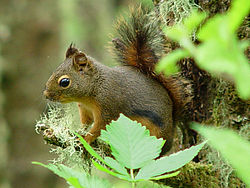Distribution
The Collie's squirrel is native to the western coast of Mexico, including the states of Sonora, Chihuahua, Sinaloa, Durango, Nayarit, Jalisco, and Colima. [3] The species inhabits areas of thick tropical and subtropical vegetation, especially in Jalisco. It is also known to occupy subtropical canyons in the northern part of its range. [4]
Description
Sometimes referred to as a "gray squirrel" in Mexico, the Collie's squirrel is a medium-sized squirrel with a gray coat. The back (dorsum) is usually a darker gray with a yellowish wash down to the tail's base. The species sides are usually a light gray and the underside is typically white, although it can sometimes be a light orange color. The top of the tail, except for the base, is black with a wash of white. The underside of the tail is gray and the sides are white. [5]
Recorded measurements of the Collie's squirrel show that female specimens average 243.4 mm from head to the base of the tail, with a tail length of 260.4 mm. Males average 248.6 mm from head to the base of the tail, with a tail length of 243.2 mm. Females were recorded as weighing 440.8 g, while males averaged 335.2 g. [6]
This page is based on this
Wikipedia article Text is available under the
CC BY-SA 4.0 license; additional terms may apply.
Images, videos and audio are available under their respective licenses.





